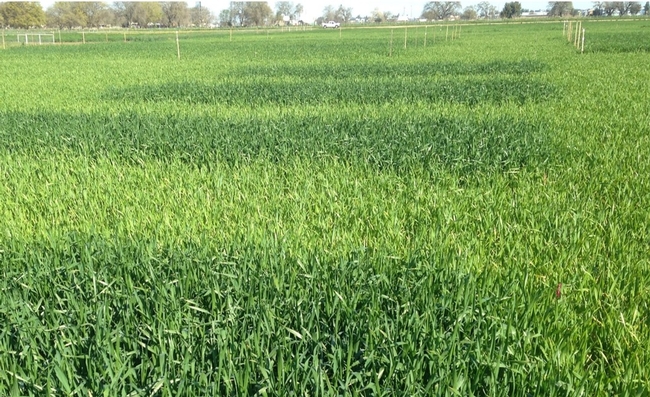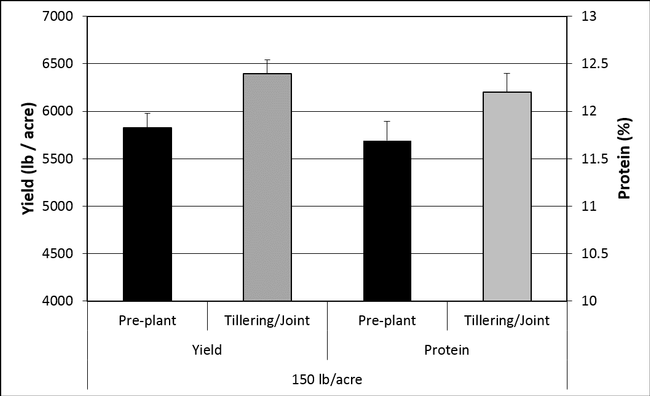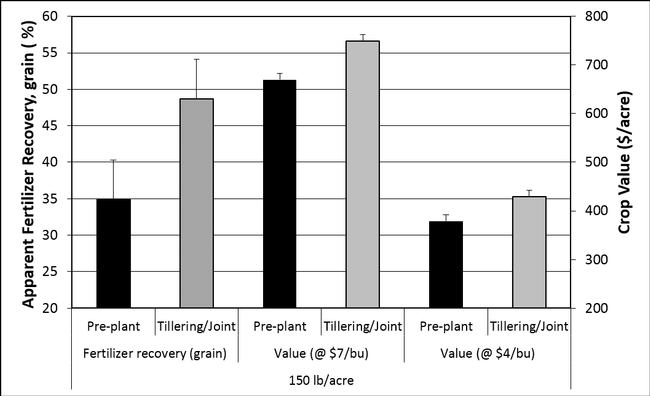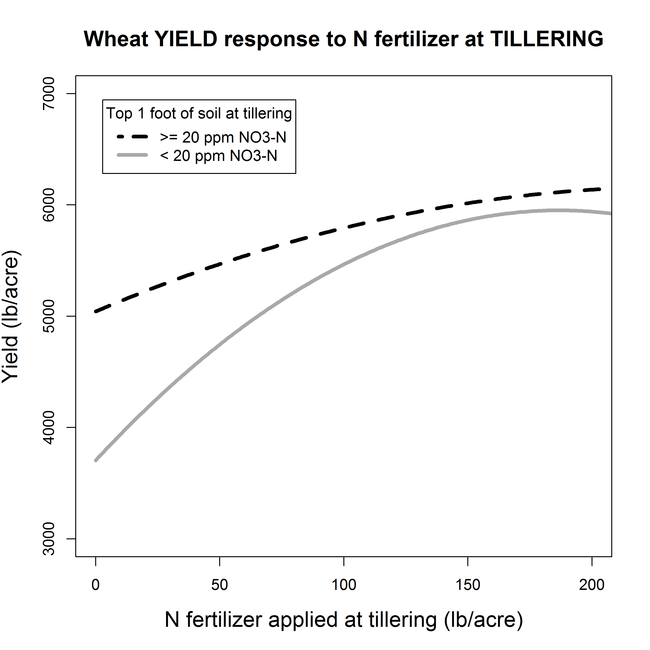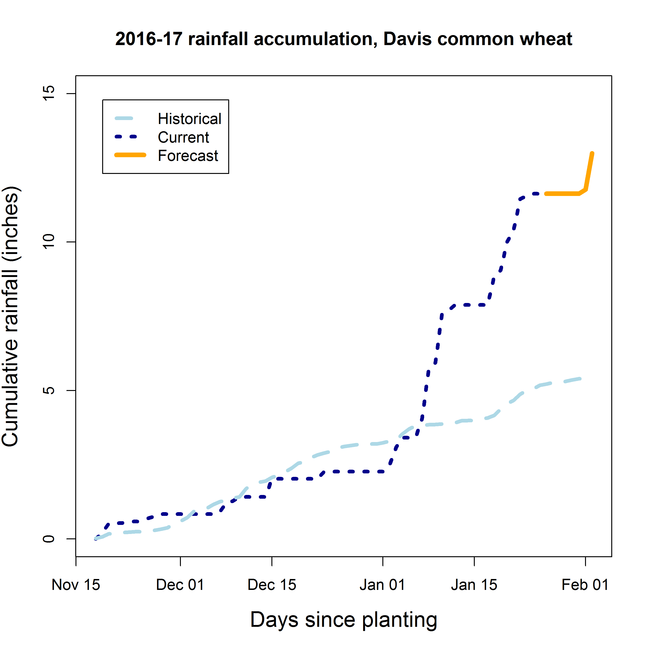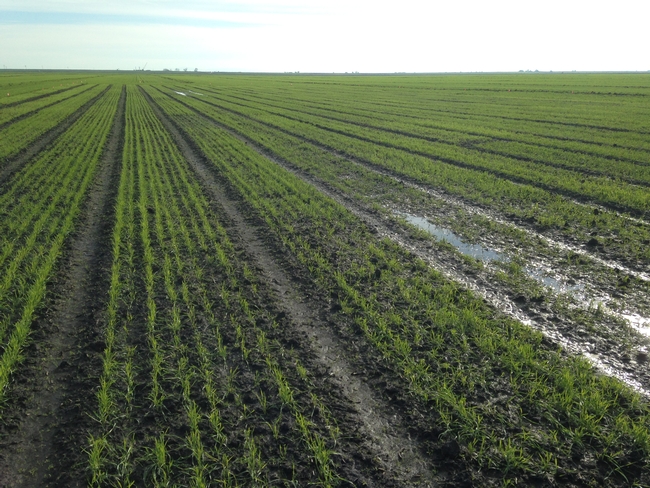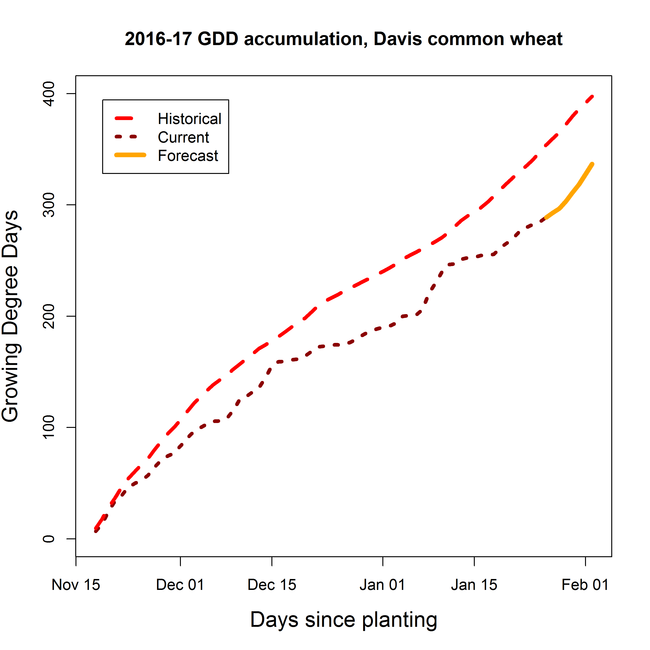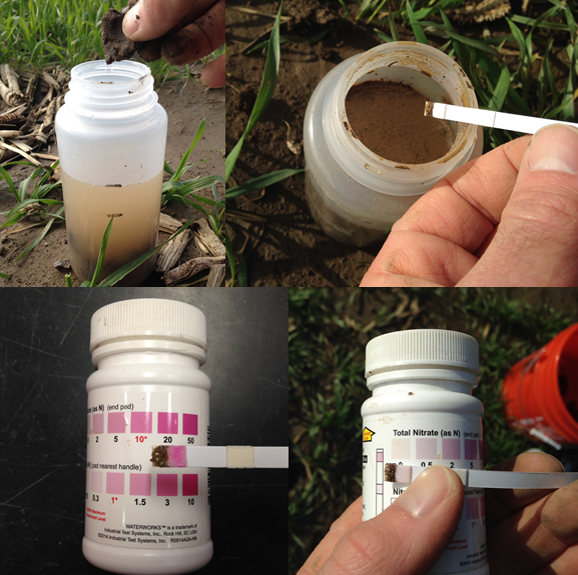Over the past 4+ seasons, a UCCE team (Lundy, Orloff, Wright and Hutmacher) has revisited nitrogen (N) fertilization recommendations for hard spring wheat specific to California conditions. We have grown wheat under a wide range of conditions and soil types, while varying the timing and quantity of N fertilizer to create conditions of N deficiency and sufficiency at the various times in the season when a grower might consider a N topdress.
Image 1. Hard spring wheat (UC Patwin 515) grown in the 2014-15 season in Davis where N fertilizer (urea) was/was not broadcast-applied near the beginning of February.
The yield and protein benefit of N fertilizer applied from the tillering-to-jointing stages is a consistent and reliable conclusion from our research on N timing and rates across a large number of trial locations. Because now is the window for a tillering-stage topdress N for much of the fall-planted wheat in the state, the goal of this blog post is to 1) communicate the overall benefits of applying N at this stage in the season, and 2) demonstrate how we are applying the results of this work to the management of our variety testing program plots right now!
Overall benefit of N applications at the tillering-to-jointing stages (Feekes 4-6).
In our trials, tillering applications resulted in significantly higher yields and protein compared to the pre-plant application of an equivalent amount of N fertilizer. Tillering applications of N fertilizer resulted in an overall 10% increase in yield and an increase in protein concentration of 0.5% points compared to a pre-plant application (Figure 1). This is the average response across trials where yields ranged from 2000 to 8000 lb/acre (average = 6000 lb/acre) and protein concentrations ranged from 7% - 15% (average = 12.5%), and where overall crop responses to fertilizer N were strong, absent, and somewhere in between.
Figure 1. Effect of 150 lb/acre fertilizer N applied either pre-plant or at the tillering-to-jointing stages of growth on hard spring wheat grain yield and protein concentration. Figure is based on 9 site-years at 3 locations in the Sacramento Valley, the San Joaquin Valley and the Intermountain Region of California.
This increased yield and protein response to N fertilizer applications at tilllering also resulted in increased fertilizer use efficiency and overall crop value compared to pre-plant applications (Figure 2).
Figure 2. Effect of 150 lb/acre fertilizer N applied either pre-plant or at the tillering-to-jointing stages of growth on hard spring wheat apparent fertilizer recovery and crop value. Figure is based on 9 site-years at 3 locations in the Sacramento Valley, the San Joaquin Valley and the Intermountain Region of California.
Furthermore, where fields had concentrations of soil nitrate-N (NO3-N) < 20 ppm in the top foot at the time of tillering N application, the yield response to N fertilizer application at tillering was larger (Figure 3).
Figure 3. Response of hard spring wheat to varying rates of N fertilizer applied at the tillering-to-jointing stages of growth where soil nitrate-N concentrations in the top 1 foot of soil were either ≥ 20 ppm NO3-N or < 20 ppm NO3-N at the time of application. Figure is based on 7 site-years at 3 locations in the Sacramento Valley, the San Joaquin Valley and the Intermountain Region of California.
For example, for 100 units of N fertilizer applied where soil NO3-N was less than 20 ppm in the top foot of soil, wheat yields increased 1,760 lb/acre compared to 750 lb/acre where soil NO3-N was greater than 20 ppm (Figure 3). Based on these data, even with wheat prices at 15-year lows, applying 100 units of N under conditions where soil nitrate-N concentrations are < 20 ppm could still add around $100/acre to gross crop value. This is definitely something worth looking into…
How can we apply this information to our management of this year's fall-planted crops in the coming days and weeks?
Because of the higher than average precipitation this season, particularly in the northern part of the state, there have been ample opportunities for nitrogen losses in the crop root zone. Nitrate moves with water and there has been a lot of rainfall since planting (Figure 4).
Figure 4. Cumulative and forecasted rainfall at the UC small grain variety testing program Davis location since planting on 11/17/2016 compared to a 10-year average over the same period.
Waterlogging can also exacerbate nitrogen losses due not only to the nitrate leaching associated with the large volumes of water moving through the soil profile but also via denitrification. The generally saturated conditions so far this season combined with high precipitation intensity have resulted in periodic waterlogging at a number of our variety trial locations (Image 2).
Image 2. Waterlogging at the UC small grain variety testing program Delta location on 1/6/2017.
Conditions have also been cooler than average so far this season, meaning that there has not been as much crop growth and N uptake this year compared to more average temperature conditions (Figure 5). It also means that there is much crop growth ahead and a lot of yield potential yet to be determined.
Figure 5. Cumulative and forecasted Growing Degree Days (GDD) at the UC small grain variety testing program Davis location since planting on 11/17/2016 compared to a 10-year average over the same period.
What does this mean for crop management in the coming weeks? Opportunity.
This next section will illustrate how we are applying the results of our recent work to the management of our variety testing program plots at our Davis location. While we think it is instructive to demonstrate how we are applying these tools to our own management of this year's crop, it is important to recognize that it is a particular location with particular circumstances and conditions. Therefore, our management actions may or may not be appropriate at a different location (e.g. if waterlogging has greatly reduced the yield potential of a stand, a topdress of N at this stage may not be warranted). The goal is to illustrate our sequence of thoughts and the decisions we are making based on the data we have compiled for the conditions at our particular location. We encourage readers to go through a similar process at their own location. If you are interested in guidance through that process at your particular location, please feel free to reach out to me.
Looking at the forecasted rainfall next week for our Davis variety trial location (Figure 5), we are hoping to get onto the field to topdress N fertilizer at this location ahead of the rainfall next week. A topdress of urea shortly before a precipitation event of > 0.5” will ensure that the fertilizer granules dissolve and that the N moves into the root zone of the crop and becomes quickly available in soil solution.
To decide whether and how much N fertilizer to apply, we are approximating current soil nitrate-N concentrations in the top 1 foot of soil using a simplified version of the soil nitrate quick test procedure developed by our UC Cooperative Extension colleague Tim Hartz (that version is here). Basically, our version (instructions here), uses a larger total volume of water, eliminates the addition of calcium chloride as a flocculent, and requires shaking the soil-water solution vigorously for at least 3 minutes (time yourself—it is harder than you might think to continuously shake a bottle for 3 minutes). We also wick the moisture from the solution with the nitrate test strip to be able to get a reading immediately from the solution rather than waiting for the soil particles to settle. Image 3 depicts two of the steps for the in-field soil nitrate quick test we performed on 1/25/17 at our Davis location, and a comparison of the results from this week's test to a test we did prior to planting in November at our the same site.
Image 3. Depicts steps from a 1/25/17 soil nitrate quick test at the Davis UC small grain variety testing location (top), and a comparison of the most recent quick test results (bottom right) to the results from a quick test conducted at the same location prior to planting (bottom left).
The results of our recent in-field quick test indicate that there has been a considerable decrease in soil NO3-N concentrations since our pre-plant sample in November and that our current soil NO3-N concentrations in the top 1 foot of soil are well below the 20 ppm threshold. This means that we are likely to see a strong response to a tillering-stage application of N fertilizer, particularly for the first 100 units of N applied at this stage. As a result, we are planning to topdress urea as soon as the field conditions permit. We should note that because jointing occurs around 650 growing degree days (GDD) (see Table 1 here) and we are at just over 350 GDD at our Davis site, there will probably still be time for an application even if we miss the window ahead of the next storm (To calculate GDD for your site/planting date, use upper and lower thresholds of 86 and 45 °F. There is a tool for calculating GDDs here—be sure to scroll to the bottom of the page to find the tool).
To summarize the main points of this post: 1) The tillering stage is the most efficient period of crop growth to apply N fertilizer (assuming that water follows the application) and applications of N at this stage consistently add value to wheat crops under a range of California cropping conditions. 2) Determining the current concentration of soil nitrate-N in the top 1 foot of soil will greatly improve a site-specific and real-time understanding about the likelihood and magnitude of crop response to fertilizer N application at this stage of growth.
If you are managing a fall-planted wheat crop and considering a topdress of N fertilizer in the next few weeks, we encourage you to take a soil sample for NO3-N in the top 1 foot of the soil profile. Having your soil analyzed at a laboratory may be a viable option, depending on your timeline for management, but if you would like to try the soil nitrate quick test at your field and need some guidance, feel free to let us know.
